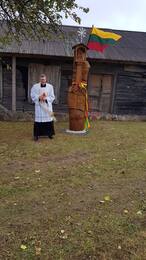The Last Battle in the Swamp Forest
On August 13, 1949, a fateful battle took place in Radviliškis County, in the Užpelkės Forest, during which Bronius Liesys-Naktis, a member of the Presidium of the Council of the Lithuanian Red Army and a signatory of the February 16 Declaration, was killed, along with other partisans of the Prisikėlimų district.
Viktoras Šniuolis-Vytvytis, a participant and witness of the battle, remembers: "On August 10, 1949, Žadgaila marched from Kęstutis district. A couple of days later, on the evening of August 12, Svajūnas, Žadgaila, Naktis, Džiugas and I gathered the necessary documentation, took a rotator and a typewriter and marched to the Užpelkės forest [...] Having marched about 20 km, we reached the Užpelkės forest at dawn. There, having arrived the day before, four rebels were already waiting.
A beautiful morning of August 13th dawned. I was on duty in the camp, and another partisan was on guard duty farther away. The liaison officer Dangus came and said that the area was quiet, that my mother was preparing breakfast, which she would bring soon. While talking to the liaison officer, I noticed that the camp was surrounded by Chekists and I shouted: 'Men, danger!'
A hellish fire broke out. The Chekists wanted to push us out into the open, but Svajūnas gave the command to break through the encirclement ring and push into the depths of the forest. We pushed in a planned manner, with escapes, covering each other with fire. When I finished breaking out of the encirclement ring, I made an escape and, having established myself behind a thick tree, opened fire. At that moment, Žadgaila changed position. Having caught up with me, he suddenly groaned, grabbed his chest and crouched. I changed position once more and Naktis crouched on the other side of me [...]
About 20 meters from us lay Svajūnas. He had to change position, but only after turning his head towards us did he stay in place and continue to cover us with fire. That was his last look... We retreated, and he sacrificed himself, stayed and died..."
Related timeline
Related topics
Related objects
Sąjūdis Memorial to Lithuanian Freedom Fighters in Minaičiai (Minaičiai Bunker-Museum)
In the autumn of 1948, the farm of partisan supporters A. and S. Mikniai in the village of Minaičiai (Radviliškis district) was chosen as the wintering place for the Prisikėlimo Military District headquarters. The partisans dug a small bunker under the barn to house the staff of the district.
On 16 February 1949, the partisan commanders in Minaičiai finalised and published the declaration of the Lithuanian freedom struggle “Sąjūdis”. The main aim of the Declaration was to restore Lithuania to a parliamentary republic (as it was from 1920–1926). Eight people formally attended the meetings: Jonas Žemaitis- Vytautas, Juozas Šibaila-Merainis, Petras Bartkus-Žadgaila, Adolfas Ramanauskas-Vanagas, Aleksandras Gribinas-Faustas, Vytautas Gužas-Kardas, Leonardas Grigonis-Užpalis, and Bronius Liesys-Naktis.
The bunker was also used later. A partisan pharmacist Izabelė Vilimaitė-Stirna treated partisan Laurynas Mingilas-Džiugas, who was seriously wounded in the Battle of Užpelkiai. In 1953, the unoccupied bunker caved in and the owners earth-filled it.
In 2010, the work on the restoration of the partisan bunker and barn, as well as the construction of the monument began. The monument, created by sculptor Jonas Jagėla, bears the names of the partisans who signed the Declaration. An authentic, glassroofed partisan bunker has been built in the barn, and the visitors are provided an opportunity to see it from above; there is also an exhibition in the barn.
Partisan liaison officer's homestead in Saiai
The homestead of the partisan supporters of the Sajės in Balandiškis, Grinkiškis eldership, Radviliškis district, is connected with the struggles for freedom in Lithuania. Its history is usually presented together with the Mikniai homestead, located in nearby Minaičiai (Lithuanian Freedom Movement Memorial).
This secluded and modest homestead, according to the recollections of Viktoras Šniuolis-Vitvytis, an eyewitness to the events, and confirmed by some research, was the place where the founding documents of the Lithuanian Freedom Struggle Movement (LLKS) were probably prepared. The LLKS became the most important organization of resistance to the Soviet occupation, covering the entire territory of Lithuania. It is reported that since 1946, freedom fighters had been visiting this homestead to rest and get some strength. After the partisan liaisons held a congress of partisan commanders at the Mikniai homestead in February 1949, the headquarters of the LLKS Public Division operated in the Sajai homestead (in a bunker installed in a barn), and the LLKS periodical, the newspaper "Prie rymancių rūpintojėlio", was published.
Partisans visited the bunker of the Sajai homestead many times, wintered there, or were treated for injuries. The hearth of freedom existed in the Sajai homestead until 1952. In the autumn of that year, the bunker was discovered, and the owners of the homestead were arrested.
Currently, the homestead is almost completely dilapidated, but it contains a monument, an information stand, and a chapel pillar to commemorate important historical events that took place at this location.
Monument to the partisans of the Resurrection District in Šeduva
On October 14, a monument to the partisans of the Resurrection District was unveiled in Šeduva Laisvės Square. The authors of the monument: sculptor Romanas Kazlauskas, architects Arūnas Eduardas Paslaitis and Viktorija Paslaitytė. It is a joint work of the Lithuanian Genocide and Resistance Research Center (LGGRTC) and the Radviliškis District Municipality.
Monument to the Partisans of the Resurrection District, commemorating all Lithuanian partisans who fought and died in this district in 1944-1953.
This is another monument dedicated to the memory of the Lithuanian partisan districts. The following districts have already been immortalized: Algimantas – Troškūnai, Anykščiai district, Didžioji Kova – Gelvonai, Širvintos district, Tauras – Marijampolė, Žemaičiai – Telšiai and Vytis – Vadokliai, Panevėžys district.






